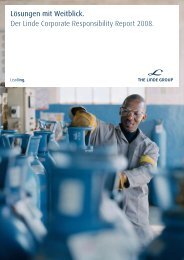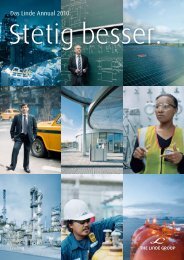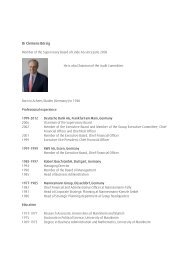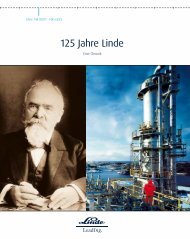The complete history of the development of The - The Linde Group
The complete history of the development of The - The Linde Group
The complete history of the development of The - The Linde Group
Create successful ePaper yourself
Turn your PDF publications into a flip-book with our unique Google optimized e-Paper software.
1893 1894 1895<br />
Swedish physicist Anders Ångström measures<br />
<strong>the</strong> total intensity <strong>of</strong> solar radiation.<br />
Air liquefaction, “<strong>Linde</strong> Air,” rectification: into<br />
new markets with new research findings<br />
With air liquefaction, Carl von <strong>Linde</strong> created <strong>the</strong> conditions<br />
needed to produce pure gases using low-temperature<br />
processes. <strong>The</strong>se gases include not only oxygen and nitrogen,<br />
but also hydrogen and inert gases – a technology whose<br />
future has only just begun.<br />
An order from <strong>the</strong> Guinness Brewery in Dublin in 1892 to develop<br />
and install a carbon dioxide liquefaction plant gave von <strong>Linde</strong><br />
<strong>the</strong> concrete impulse that started his work with low temperatures.<br />
Carl von <strong>Linde</strong> accepted <strong>the</strong> project although his company<br />
had never yet built any such plant. In 1894, von <strong>Linde</strong> began<br />
developing an early air liquefaction machine based on <strong>the</strong> knowledge<br />
gained from carbon dioxide liquefaction. He started from<br />
<strong>the</strong> idea <strong>of</strong> using <strong>the</strong> air itself as a refrigerant – using <strong>the</strong> cold<br />
generated when air moves from a higher pressure to a lower one<br />
for <strong>the</strong> additional cooling. This effect had already been described<br />
in 1862 by researchers Thomson and Joule.<br />
<strong>The</strong> process<br />
<strong>The</strong> more air is compressed, <strong>the</strong> more cold is generated when<br />
it expands. This cooling effect increases exponentially when <strong>the</strong><br />
air is pre-cooled. However, von <strong>Linde</strong> could not achieve <strong>the</strong><br />
temperature Celsius needed to liquefy <strong>the</strong> air (about minus 190<br />
degrees) from expansion from high to low pressure and precooling<br />
alone. That required a cooling cycle in which <strong>the</strong> cold<br />
generated by <strong>the</strong> expansion is transferred to <strong>the</strong> compressed,<br />
pre-cooled air in <strong>the</strong> countercurrent. In a continuous process,<br />
<strong>the</strong> cold given <strong>of</strong>f from each cycle was multiplied until <strong>the</strong> air<br />
was liquefied and could be collected in a container.<br />
While proven technology was available for compression and<br />
pre-cooling, <strong>the</strong> challenge for von <strong>Linde</strong> and his son Friedrich,<br />
who worked in <strong>the</strong> refrigeration testing station after receiving<br />
his Doctorate in physics, was to develop a suitable countercurrent<br />
German engineer Rudolph Diesel introduces<br />
<strong>the</strong> engine which will bear his name.<br />
A small air liquefaction plant by <strong>Linde</strong> could be seen at <strong>the</strong> Bavarian Industrial<br />
and Commercial Exhibition in Nuremberg as early as 1896.<br />
apparatus. <strong>The</strong>y decided on a 100-meter long double steel tube,<br />
which was wound into a spiral and well insulated, encased in<br />
wood.<br />
If at first you succeed …<br />
<strong>The</strong> first trial <strong>the</strong>n began in May. In his memoir “Aus meinem<br />
Leben und von meiner Arbeit,” Carl von <strong>Linde</strong> wrote: “Happy<br />
and excited, we watched <strong>the</strong> temperature drop according to<br />
<strong>the</strong> effect described by Thomson and Joule, even after we had<br />
far surpassed <strong>the</strong> limits within which those researchers had<br />
worked.”<br />
23


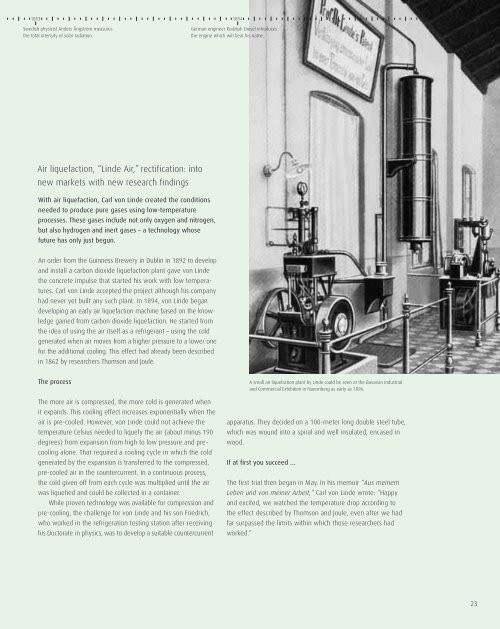
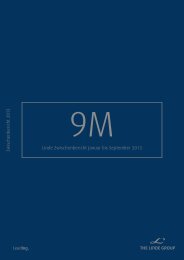
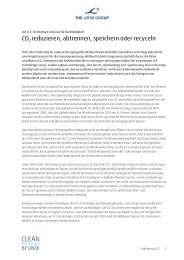

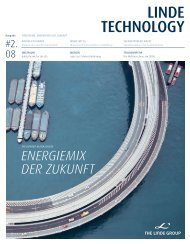
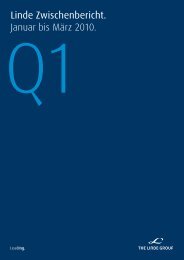
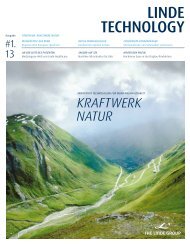
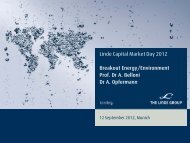
![[41] Anteilsbesitzliste des Linde Konzerns und ... - The Linde Group](https://img.yumpu.com/8356102/1/184x260/41-anteilsbesitzliste-des-linde-konzerns-und-the-linde-group.jpg?quality=85)
![[41] Anteilsbesitzliste des Linde Konzerns und ... - The Linde Group](https://img.yumpu.com/8356076/1/184x260/41-anteilsbesitzliste-des-linde-konzerns-und-the-linde-group.jpg?quality=85)
